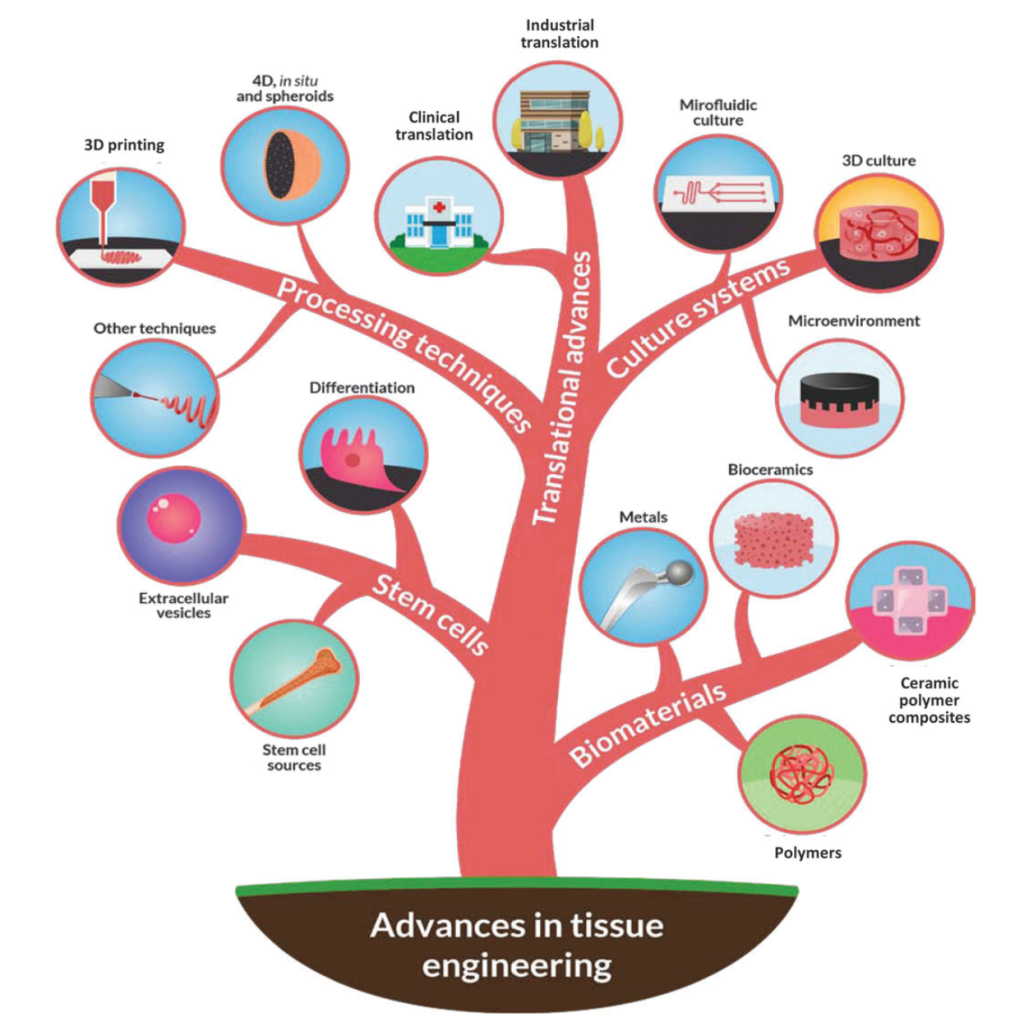32 Current State of the Art
Technological Advancements
In the years since Alan Russell’s TED talk, there have been remarkable advancements in the field of tissue engineering that offer promising potential for treating diseases and repairing damaged tissues. These developments include a range of innovative technologies and approaches, each with its own unique advantages.
3D Bioprinting
One of these advancements is 3D bioprinting, a technique that enables the fabrication of intricate three-dimensional structures using living cells. Cells are encapsulated and printed into designed structures and then crosslinked to provide appropriate mechanical properties. Tissue engineering has adopted the 3D printing technique for the fabrication of scaffolds and later to create cell-laden multicellular and complex tissue constructs. This technology holds great promise for regenerative medicine as it allows for the creation of custom-designed implants and tissues tailored to individual patients’ needs. An example of this technology includes 3D printed scaffolds of collagen/alginate hydrogel for cartilage tissue engineering.
Also, the overall cost of 3D bioprinting is lower when compared with currently used graft materials. Despite some challenges in this still developing field, an increasing number of studies have been published regarding the creation of biomimetic constructs for future clinical applications such as skin, musculoskeletal, cardiovascular, neural, and other tissues.
Organ-on-a-chip
Another significant development is the organ-on-a-chip technology. These miniature devices replicate the functions of human organs on a tiny scale, providing researchers with tools for studying diseases and testing potential therapies. By mimicking the complex interactions between cells and tissues within the body, organ-on-a-chip models offer insights into disease mechanisms and drug responses that were previously inaccessible. This technology has the potential to accelerate the drug discovery process and reduce reliance on animal testing.
Stem Cell Technologies
Induced pluripotent stem cells (iPSCs) represent another frontier in regenerative medicine. These cells, derived from adult tissues, have the remarkable ability to transform into various cell types, offering a potentially limitless source of cells for transplantation and tissue repair. Unlike embryonic stem cells, which raise ethical concerns, iPSCs can be generated from readily available adult cells, making them a more socially acceptable option for research and therapy. Researchers are exploring the potential of iPSCs in treating a wide range of conditions, from neurodegenerative diseases to heart failure.
In addition to iPSCs, advancements in stem cell technology and its application in tissue engineering include stem cell-derived extracellular vesicles (EVs). EVs are produced by cells and they cary peptides, lipids, or nucleotides such as RNA and DNA, and they have been recognized as an important means of molecular communications between cells and organs. It has been reported that EVs can participate in different stages of skin repair and regeneration and stimulate wound healing and skin tissue regeneration by regulating the inflammatory response in the wound area.
Biomaterials
Additionally, advances in materials such as smart biomaterials and synthetic polymers are driving progress in tissue engineering. Smart biomaterials are designed to interact with biological systems in intelligent ways, promoting tissue regeneration and repair. They have the ability to respond to changes in physiological parameters an outside stimulus. By harnessing the body’s natural healing process and being adaptive, smart biomaterials offer new opportunities for enhancing the success of tissue engineering therapies and implants. Synthetic polymers are popular in the field of tissue engineering because they are widely available and inexpensive, can be bioresorbable, and can be processed in a controlled and multitude of ways to make them suitable for different applications. Commonly used synthetic polymers include polylactide (PLA), polyglycolide (PGA), poly(lactide-co-glycolide) (PLGA), and polydimethylsiloxane (PDMS). Synthetic polymers can be used in combinations to build different phases of a resulting structure and they can also be combined with natural biomaterials to form semi-synthetic polymers that exhibit beneficial properties from both the natural and the synthetic material.
Dynamic Culture Methods
Dynamic culture methods are also playing a pivotal role in tissue engineering research. Cell culture is an important part of this research due to the rarity of certain cell types in the human body and the potential donor site morbidity associated with the retrieval of cells in large numbers. Because of this, cells are propagated outside the body. The techniques of dynamic culturing involve growing cells in environments that mimic the dynamic conditions found within the body, such as changes in oxygen levels or mechanical forces. By providing cells with the right cues for growth and differentiation, dynamic culture methods enhance the development of functional tissues for transplantation and regenerative medicine applications.
Current Commercial Availability
The commercial availability of new tissue engineering technologies is influenced by several factors, including regulatory approval processes and the challenges associated with translating research from the laboratory to the marketplace.
One significant factor affecting commercialization is the need for FDA approval of new biomaterials used in tissue engineering. This requirement often leads researchers to rely on existing biomaterials with established track records rather than developing novel materials. The extensive vetting process required for new materials can be time-consuming and costly, discouraging innovation in the field.
Another barrier to market entry is the slow progress in the translational efforts from bench to industry. Clinicians, the people who end up using the products/technologies, do not always have sufficient input during the early stages of development. Additionally, researchers in tissue engineering and regenerative medicine may lack experience in translational sciences, which are essential for bridging the gap between laboratory discoveries and clinical applications. To overcome this issue, there is a growing recognition of the importance of academic-industry partnerships. Collaborations between tissue engineers, clinical investigators, clinicians, and industry partners can facilitate the development and commercialization of innovative products/technologies.
Significant Milestones/Breakthroughs
The schematic below shows and overview of the major and recent advances in tissue engineering.

Media Attributions
- Highlights on Advancing Frontiers in Tissue Engineering

